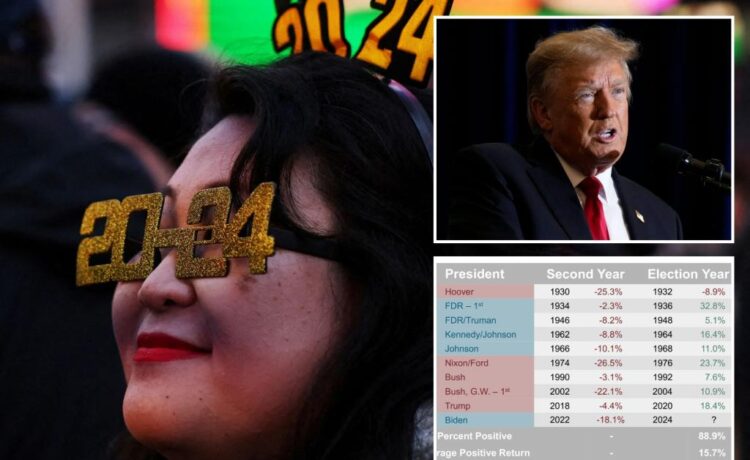
Ken Fisher
Happy New Year! It should be.
After 2023’s 26.6% return, 2024 holds more in store. Fortunately, few are lampshade-on-head gleeful. Most investors remain skeptically timid, fretting about all those “risks” you hear abundantly.
As Sir John Templeton legendarily said, “Bull markets are born on pessimism, grow on skepticism, mature on optimism and die on euphoria.”
Today’s skepticism helps. Simply said, it’s far harder to kill a young bull market than almost anyone fathoms. Once they hit a first anniversary (done in October 2023), they almost always get a second.
Hence, my forecast: Moderate double-digit S&P 500 gains, with big growth stocks leading early, and likely twisting to value stock leadership late in 2024. Maybe lampshades dance next December.
Yes, I know you think that’s stupid. Christmas Day 2022, I detailed here exactly why 2022 was more like 1966 and its bear market than any year ever — and in so many ways — so 2023’s market should react much like 1967 (without flowers in your hair). It did. The S&P’s 1967 total return was 24%. Most all of my 1966-1967 parallels happened: a no capitulation-based stock market bottom, tech led up 58%.
Ongoing inflation slowed to near normal. America’s widely anticipated 2023 recession? Somebody better put it on a milk carton. US GDP accelerated all year. That “Mid-term Miracle” thing I extolled worked perfectly, delivering gridlock’s normal stock market big bang by blocking big, controversial legislation.
While those 1966-68 parallels will start breaking down, 2024 should still resemble 1968 more than most will believe. The S&P 500 should return roughly 11%-18%. Again, no recession. Normalized inflation with the Fed claiming victory and cutting rates — but less than many hope.
A Republican, likely Trump, will win the White House. The GOP should take the Senate but probably lose the House (like and unlike 1968). I’ll handicap the political races in May.
Despite histrionics, politics are a 2024 tailwind. Since 1925 (when accurate data start), The S&P 500 climbed in 83.3% of presidential election years. Average returns: 11.4%. (Eerily near 1968’s 11.0%.) When positive, election years averaged 17.0%.
A stunning secret: Whenever the second year of any president’s term was negative, like 2022 was, the next election year, like 2024, has been positive every single time since 1932’s Great Depression bottom. No exceptions! Expect it again! Bear markets scare the bejabbers out of us. And it takes a really long time to get bejabbered back up to where we’re optimistic. (Templeton again.)
And, of course, early in election years we fear the “wrong guy” wins. That fades. Upon election, overall, we always like the winner better than we originally expected we would — improving sentiment —temporarily.
Our economy? Moderate growth will help finish inflation’s normalization (increased supply from growth is anti-inflationary, not inflationary as economists imagine) and helps growth stocks relative to value, like in 2023. But later year rate cuts likely usher in value stock leadership.
Value stocks thrive from the accelerating bank lending that rate cuts render. They need bank lending to fund expansion initiatives. That comes as rate cuts steepen the so-called “yield curve.” Banks borrow short-term to fund the longer-term loans that let mundane firms grow.
Reduced short-term rates increase bank lending’s profitability, creating more lending — helping the little piggies at the slop trough with more slop. Quite contrary to mythology, rate cuts aren’t needed for stocks to rise. 2023 proved that vividly!
Well-known worries can’t kill young bull markets. Optimism and euphoria do later. Only a supersized, surprise shock could now. None seemingly lurks. So, expect a good-to-great 2024. Maybe save those lampshades for next New Year’s.
Ken Fisher is the founder and executive chairman of Fisher Investments, a four-time New York Times bestselling author, and regular columnist in 21 countries globally.
Load more…
{{/isDisplay}}{{#isAniviewVideo}}
{{/isAniviewVideo}}{{#isSRVideo}}
{{/isSRVideo}}

